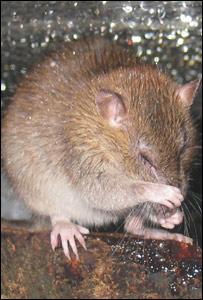KITV in Honolulu, HI reports that PETA has asked Shane Victorino, the Philadelphia Phillies star Center Fielder, to stop eating Spam. According to the PETA Files blog, Fox announcer Joe Buck, revealed that Victorino’s favourite food is a popular Hawaiian dish, Spam musubi, during a recent telecast. Ever-trusty Wikipedia says that a Spam musubi is composed of a block of salted rice with a slice of Spam (cooked or uncooked) on top, and typically nori (dried seaweed) surrounding it to keep it in shape. Mmmm. I’ve never had Spam, but meat from a can doesn’t really appeal to me.
KITV.com reports:
After finding out Victorino’s favorite food is SPAM musubi, the People for the Ethical Treatment of Animals’ Assistant Director Dan Shannon sent him a letter, calling for him to give up SPAM because its maker Hormel is under an animal cruelty investigation.
PETA released video to news organizations from one of its investigator that went undercover at the pig farms. The video showed workers beating the animals.
The PETA representatives said they realize SPAM is popular in Hawaii and that he probably did not realize the conditions the pigs faced.
According to PETA, Investigators documented that workers at the Hormel supplier kicked and injured pigs, beat pigs with metal rods, and shocked pigs with electric prods–sometimes in the face. Workers reportedly killed piglets by slamming their heads against the floor.
The PETA Files also says that:
Phillies’ Citizens Bank Ballpark has been ranked the "Most Vegetarian Friendly Ballpark" two years in a row for its impressive vegetarian offerings, such as Philly faux-steak sandwiches, "crab-free crab cakes," mock-chicken sandwiches, and veggie dogs.
I’ve never been to Citizens Bank Ballpark, but I did have an awesome cheesesteak at a Phillies game at the Vet a few years ago.
Maybe this video clip is a bit predictable…. oh well.

 The American Veterinary Medical Association
The American Veterinary Medical Association .jpg) The ritual was documented by the writer Joseph Mitchell for the New Yorker magazine in his 1939 article “All You Can Hold for Five Bucks.” As Mr. Mitchell told it, the beefsteak came into being in the mid-1800s, became popular as a political fund-raiser and vote-buyer, and began a slow decline when women started taking part after being granted suffrage in 1920.
The ritual was documented by the writer Joseph Mitchell for the New Yorker magazine in his 1939 article “All You Can Hold for Five Bucks.” As Mr. Mitchell told it, the beefsteak came into being in the mid-1800s, became popular as a political fund-raiser and vote-buyer, and began a slow decline when women started taking part after being granted suffrage in 1920.
 Across New York City, the owners of delis and bodegas say, in this morning’s
Across New York City, the owners of delis and bodegas say, in this morning’s  The saga began in early November when a 19-year-old resident noticed the water was "smelly" and she began feeling ill.
The saga began in early November when a 19-year-old resident noticed the water was "smelly" and she began feeling ill.

 Murray’s Cheese in New York City perpetuates poop.
Murray’s Cheese in New York City perpetuates poop..jpg) The latest
The latest